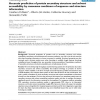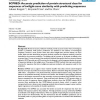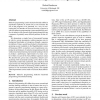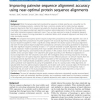93 search results - page 2 / 19 » Homology Induction: the use of machine learning to improve s... |
BMCBI
2007
13 years 5 months ago
2007
Background: Structural properties of proteins such as secondary structure and solvent accessibility contribute to three-dimensional structure prediction, not only in the ab initio...
BMCBI
2008
13 years 5 months ago
2008
Background: Protein structure prediction methods provide accurate results when a homologous protein is predicted, while poorer predictions are obtained in the absence of homologou...
HAIS
2009
Springer
13 years 10 months ago
2009
Springer
Abstract. Protein membership prediction is a fundamental task to retrieve information for unknown or unidentified sequences. When support vector machines (SVMs) are associated with...
AAIP
2009
13 years 6 months ago
2009
Inductive programming systems characteristically exhibit an exponential explosion in search time as one increases the size of the programs to be generated. As a way of overcoming ...
BMCBI
2010
13 years 5 months ago
2010
Background: While the pairwise alignments produced by sequence similarity searches are a powerful tool for identifying homologous proteins - proteins that share a common ancestor ...




